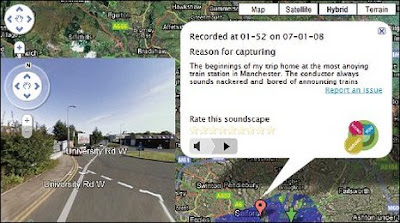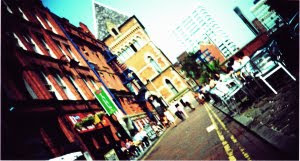Saturday 30 January 2010
Piano trap
Fun test to see. Researchers seek ways that more people took the stairs instead of the escalator. a better choice of health considerations. The researcher slightly adjusted the subway station in St...
Fun test to see. Researchers seek ways that more people took the stairs instead of the escalator. a better choice of health considerations. The researcher slightly adjusted the subway station in Stockholm Odenplan . There is piano music from the keys (steps). a nice interaction between man and computer. The study showed that 66% more people than normal chose the stairs over the escalator.
Golan Levin & Zack Lieberman: Manual Input Sessions
Meet the Media Guru session @ Mediateca, Milan Flickr images from event here: http://flickr.com/photos/fa...
Meet the Media Guru session @ Mediateca, Milan
Flickr images from event here: http://flickr.com/photos/fa...
Category: Howto & Style
Tags:
golan levin zack lieberman performance milan MIT interaction media
Davide Tidoni - Le retour à la raison
WWW.DAVIDETIDONI.NAME Le Retour à La Raison is a short film by Man Ray. It was originaly mute (1923). I added sound.
WWW.DAVIDETIDONI.NAME
Le Retour à La Raison is a short film by Man Ray. It was originaly mute (1923). I added sound.
Category: Music
Tags:
man ray dada surrealim sound design
Researchers seek UK 'soundscapes'

A project has launched to capture the sounds of UK locations, mapping them to create "soundscapes" that can be visited by users of the project's site.
Participants are asked to record 5 - 10 second intervals of sound using their mobile phones, describing where and why they took the recording.
The sound samples are then uploaded to a site where they are mapped.
The project aims also to analyse the recordings and provide an objective measure of sound and noise.
The Sound Around You project is the brainchild of University of Salford acoustics researcher Charlie Mydlarz.
Objective measure
"The government looks at sound and noise in a very one-sided, black and white fashion: if something's too loud, that's bad and if something's quiet that's good," Mr Mydlarz told BBC News.
"That's not really true. You do need a certain amount of volume within a sound environment for it to be appreciated - a marketplace needs to be bustling for it to be a marketplace.
"Before we make any judgments about these soundscapes and how people react to them we need to gather information about them," he explained.
Participants in the project can thus rate the sound that they record, and tag it as "tranquil", "eventful", "chaotic", and so on.
The resulting map laying out Britain's soundscapes can be visited by, for instance, prospective house buyers interested to know about the sound environment of a given neighbourhood.
But the results are also useful from a research standpoint, Mr Mydlarz said.
The audio clips will be acoustically analysed and associated with the characteristics of the recordings that participants use to describe them.
The project thus hopes to discover in a rigorous and objective way what kinds of sounds make for pleasant or unpleasant locations.
The Sound Around You project was launched at the Manchester Science Festival.
Archival Sound

Soundscapes
The word "soundscape" was coined by composer R. Murray Schafer to identify sounds that "describe a place, a sonic identity, a sonic memory, but always a sound that is pertinent to a place" (Wagstaff, G. 2000). More.
Selected recordings can be played by anyone
All recordings on this site are governed by licence agreements.
Browse this collection
There are several ways that you can browse the recordings in this collection:
* Browse by map
* Browse by type of sound
* Browse by Sound Archive collection
* Browse by location
positive soundscapes

The Positive Soundscapes Project was a unique research effort which sought to re-evaluate environmental sound.
Background:
The project set out to give a rich and rigorous account of human perception of and response to soundscapes. To do this it used overlapping methods from a wide range of disciplines, ranging from the quantitative (e.g. acoustics) to the qualitative (e.g. social science) to the creative (e.g. sound art). Qualitative fieldwork (soundwalks and focus groups) determined that people conceptualised a soundscape into three components: sound sources (e.g. a market), sound descriptors (e.g. rumbling) and soundscape descriptors (e.g. hubbub). Lab-based listening tests along with the fieldwork have revealed that two key dimensions of the emotional response to a soundscape are calmness and vibrancy. In the lab these factors explain nearly 80% of the variance in listener response. Interview responses from real soundscapes further indicate that vibrancy can be expressed in two sub-dimensions expressing variation over time and over sound mix. Physiological validation of the main dimensions is provided by images of changes in the brain during listening from fMRI scans and by changes in heart rate. Artistic work and the public responses to it illustrate the huge range of sounds and soundscapes considered positive. Tools for simulating soundscapes have been developed and seem to be effective for several purposes, including design and public engagement - that is, sound play. The project results will lead to new metrics and assessment methods for soundscapes, new ideas for design and user engagement and, perhaps, better policy on environmental noise.
SOUNDSCAPE
THEME: Soundscape
“The world is never quiet, even its silence eternally resounds with the same notes, in vibrations which escape our ears. As for those that we perceive, they carry sounds to us, occasionally a chord, never a melody.” Albert Camus
“Sound--That stealeth ever on the ear of him
Who, musing, gazeth on the distance dim,
And sees the darkness coming as a cloud--
Is not its form--its voice--most palpable and loud?” Edgar Allan Poe
“The silence was part of the story I wanted to tell.” Joyce Maynard
“Music is the movement of sound to reach the soul for the education of its virtue”. Plato
“The world is never quiet, even its silence eternally resounds with the same notes, in vibrations which escape our ears. As for those that we perceive, they carry sounds to us, occasionally a chord, never a melody.” Albert Camus
“Sound--That stealeth ever on the ear of him
Who, musing, gazeth on the distance dim,
And sees the darkness coming as a cloud--
Is not its form--its voice--most palpable and loud?” Edgar Allan Poe
“The silence was part of the story I wanted to tell.” Joyce Maynard
“Music is the movement of sound to reach the soul for the education of its virtue”. Plato
Subscribe to:
Posts (Atom)
